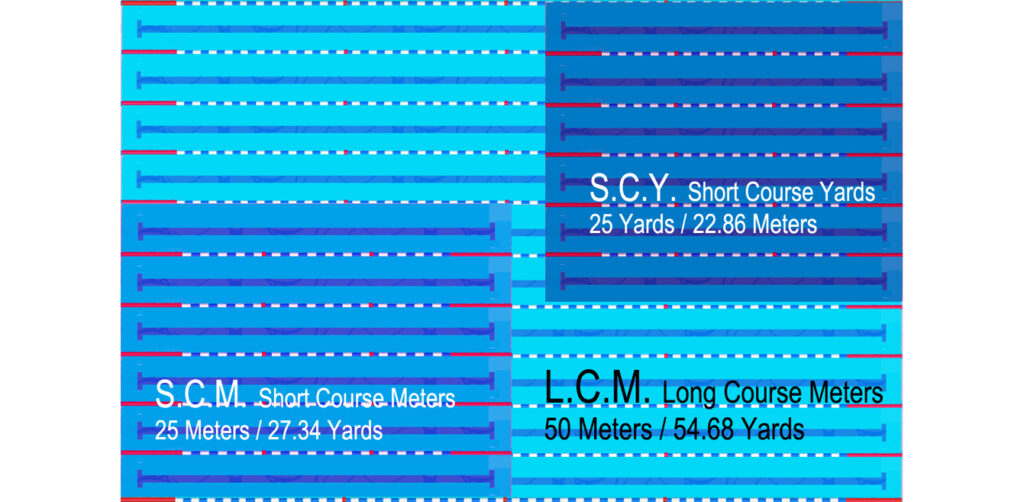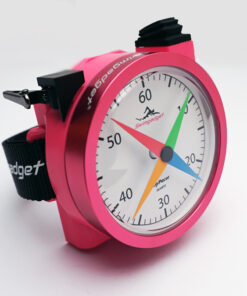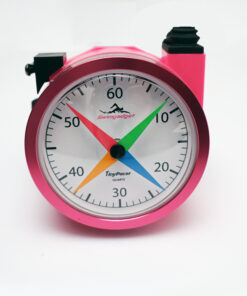Swim a Workout
Getting in a pool to just swim straight through is not the best way to swim, even if your goal is to be able to swim a certain distance like a mile or a km. It is much better if you do sets of several repetitions that will allow you to focus on different aspects of your fitness and swimming technique.
Define a goal, focus on it and work it out. The goal may be to finish an open water race, or to master all styles or strokes, or to qualify to a World Master event, or just to make a personal record, Achieving your goal will result in a much more effective swimming and improved physical condition.
Swim Workouts are generally broken into sub-groups, and this subgroups are divided into “sets”.
How to use a Tiny Pace Clock?
Pace clocks are normally situated on the wall of your local pool and they are used to swim the sets. You can check your speed, control your breaks and even calculate your heart rate. And for those whose pool does not have a Pace Clock, well that is why we are here.
Dynamic Swim Workouts.
Swimming workouts are normally divided sub-groups and then into various sets depending on the purpose. Normally a good workout consist on: A warm up, Technical Drills, Kick set, pull set, main set and cool down, and each group could be divided into various sets which are frequently repeated.
To avoid making swimming boring, make it dynamic, meaning you have to change the way you swim each set and the tools.
There are various aspects that need to be mastered in order to improve your swimming, depending on your own purpose you can adapt your swimming to improve and or to reach your goals.
Here are some examples.
Besides the importance of increasing muscle and body temperature and getting your blood flow running, during warm up, you will be adapting to the water to be able to feel your catch and the sensation of gliding through the water. Warm up normally represents about 20% of the total.
If you are swimming in a new pool during warm up you will adapt and adjust your turns, Some pools have slippery walls, others have their “T” mark at a different distance or because of the light you will see them at a different distance. In case you are sharing the lane with other swimmers, during warm up you will know what you will find during your swim.
Warm up Example: 500
2x 250 100 Drill 100 Hypoxia B 3/4 50 Ae1 rest 10”
Swim 100 / 50 meters Catch up 50 brush
100 /50 Breathing every 3 strokes 50 Breathing every 4 strokes
50 Aerobic 1 (60% effort)
Repeat
Warm up Example: 400
100 Swim rest 10´´
100 Backstroke rest 10´´
100 50 Swim 50 Drill rest 10´´
100 Kick 50 Free 50 Back Kick rest 10´´
Swim 100 / Swim 100 Freestyle easy rest 10”
100 / Swim 100 Backstroke easy rest 10”
100 / Swim 50 easy (about 50% effort) 50 Drill Cath up
100 / Just kick 50 Free with Kickboard 50 Kick Backstroke
Swimming is one of the most challenging sports. There are no supports and you have to force yourself to push through an environment that is 700 times denser than air; terms like drag, hipoxia, body position, etc., in order to increase your swimming efficiency. There are Drills that help you swim more efficiently, faster and for a longer distance.
Each Drill is designed with a goal. While doing them you should focus just on your technique and not on your speed. Check your hand entry, arm trajectory, high elbow catch, fingers pointing to the bottom, hand with finger relax, your head positions, leg positions, balance, shoulder rotation etc.
For each Stroke there are specific Drills, here are just a few examples.
Freestyle Catch Up Drill:
Goal: Distance per stroke. Set a rhythm for the stroke by slowing the tempo and control the rest of the body while you swim.
Swim freestyle with one exception; You have to wait for one arm stroke to be completely finished before starting the next stroke, one arm waits up front during all the drill. You need to have a strong kick throughout this drill to keep a high body position.
Freestyle Fingertip drag:
Goal: Learn arm recovery with high elbow and to increase the feeling of the catch.
Swim freestyle with one exception; When you recover your arm drags your finger tips along the surface of the water. While the recovery arm is dragging water, you should feel the water harder on your catch with your oposite hand. Focus on being slow and on your strokes. To maintain a good body position use your core and legs to stay on the surface of the water.
Hypoxia is an activity state in which oxygen is not available in sufficient amounts. The goal is to be able be able to push longer from the wall, perform the flip turn easier and to be able to swim several cycles without the need of breathing. This is useful if you need to increase your speed dramatically in case you need to overtake a swimmer. A good capacity of hipoxia would be to be able to swim underwater a 25 pool.
Freestyle Hypoxia Drills.
Goal: Train yourself to breath with different patterns.
2 x 200 50 Hypoxia B3 50 B4 50 B3 50 B5
Swim freestyle changing your breathing pattern every 50. You have to swim at a speed that feels confortable, take in air and exhale very slowly to trick your head that you are breathing while you are swimming.
Freestyle Hypoxia Drills.
Goal: Train yourself to hold your breath during your underwaters kicks.
2 x 200 Dolphin Kick +1 per 50: 1st 50 1D 2nd 50 2Dk 3rd 50 3Dk 4th 50 4Dk
Swim freestyle changing your Dolphin Kicks every 50: First 50 one Dolphin Kick, Second 50 two Dolphin Kicks, Third 50 three Dolphin Kicks and Fourth 50 4 Dolphin Kicks. Breath every two strokes during your swim in order to have enough air for the turns.
Swimming intensity is not proportional to the speed. Theoretical square law applies, meaning that a swimmer that swims a 50 in 50 seconds and wants to reduce the time to 25 does not have to double the intensity; he needs to quadruple it.
Following this law, increasing your intensity from 60% to 90% will not drop your time by 20% but just to a much smaller fraction.
Intensity Levels are meant to define the effort you need to put into a swim set.
Undefined Swimming : Easy Swimming
Aerobic 0: 60% Effort
Aerobic 1: 70% Effort
Aerobic 2: 80% Effort
Aerobic 3: 90% Effort
FULL SPEED
Depending on the D.DI.R.T, the set goal will vary. Most of the time your swimming will be on Aerobic 1, where you can comfortably swim for around 40 minutes working on your zone 2.
And around 20% of your weekly swimming will be in Aerobic 2 for medium distance sets, 100´s with short periods of break and leaving Aerobic 3 for short distances like 50´s with longer periods of rest and Full speed 25´s for short distances and U.S.R.P.T. types of sets. This intensity can be associated with V02 max zone.
Some sets are created in order to train over your Lactic acid tolerance at very high intensity levels.
Mastering all 4 strokes is challenging but also makes your swimmig session much more dynamic.
Following the Individual medley order we have:
Butterfly, Backstroke, Breaststroke and Freestyle.
The official rules from F.I.N.A. * dictates that it is permissible to be completely submerged not more than 15 meters after the start and each turn. These rules applies to all strokes except to breast stroke, limited by one arm stroke, one butterfly kick and one Breaststroke kick.
This means that for every 100 you can swim almost 60 % underwater. This is mostly used for racing but for every lap you can glide a few meters off the wall just by having a good technique and a nice streamline position.
This underwater swimming is so important that it is defined as the fifth stroke, and it is performed by doing underwater dolphin kicks and underwater dolphin kicks upon your back in backstroke (fastest way to swim).
https://resources.fina.org/fina/document/2023/01/04/65961a45-bde5-4217-b666-ca1f5dc2d1f0/1_Swimming-Technical-Rules.04.01.2023.pdf
Kicking is an important part of swimming. In every stroke, it provides stability, power and propulsion. Normally in Freestyle you have many types of kicking. The main are a two beat kick used for open water and long distances that help you glide through the water using you legs more like a rudder. And a six beat kick which is more used for sprinters and it is a power kick.
A six beat kick is when your do six kicks per arm cycle (a cycle is a right arm pull and a left arm pull). The rhythm is three kicks on each arm and its difficulty is to synchronize each kick to each part of the pull. Normally at the time of the catch phase you have to kick with the same side leg.
Using a two beat kick you minimize the energy cost of the legs because legs take the most energy from the body when you exercise. Using a two beat kick will allow you to have more endurance. The key is to swim very efficiently with a two beat kick since you only kick with two kicks per cycle. This way it is easier to synchronize. Normally the catch phase goes at the same time as the same leg kick. It should be very balanced and very efficient.
Normally there is always a set of kick in every practice. Kicking can be done with: a kickboard, with a snorkel maintaining a streamline position, with fins and it can be freestyle, butterfly, breaststroke or backstroke floating on your back.
A good rule to check if your kick is weak is to compare your time kicking in a 50 vs your time in freestyle in 75. If your time kick on the 50 is higher you have to work more on your kick.
Freestyle kick set.
4 x 50 Kick free board Aer 2 @1:30 200 Kick Free 4 positions.
Freestyle Kick with the Kick board, coming out of the wall every 1:30
200 Kick Free 4 positions.
Using freestyle kick changing position every 50, one facing down (freestyle) one backstroke, one on your right side and one on your left side.
Swimming open water is different from swimming in a pool, you do not have the black line that helps you swim straight, you have to face currents and waves and you have very little visibility. If you do not have access to swim in open water you can still train physically in order to perform once the open water season starts.
Depending on the distance you plan to swim in open water you have to train at a significantly higher volume in order to compensate the lack of walls, currents and possible waves. Some of the sets include Descent, which means that you have to improve your speed of your second set and make it faster than your first.
The fact that there are no turns or walls is compensated with the increase of buoyancy when swimming in salted water.
Sometimes the rules of the open water race allow the use of a swim suit. This increases the buoyancy to a level that may improve your speed significantly.
Open water swimming requires you to lift your head every 6 or 8 strokes in order to guide yourself to the next buoy and adjust your direction. Training in the pool there is a black line to guide you but you can still practice to lift your head to check the time of the pace clock when you are about to make your turn. This will allow you to increase or decrease your speed in order to maintain your goal time and it will serve as an eye sight practice.
Example of a long distance set.
2 x (3x 200 on 30 second rest)
Descend on the second set, each 200 gets faster.
This sets requires you to start a steady pace and being able not just to hold your speed but to increase it during the last three 200´s.
Example for maintaining your Race Pace.
10 x 100 Freestyle @1:45
Higher Pace on the First and Last. Maintain 2-9
First set a swim pace for the race, for example you may want to swim a 1500 at a 1:25 pace, this set will require you swim the first set on a 1:15 pace in order to simulate the start of the race, then maintain your cadence at 1:25 on every 100, and to increase your speed to all out in the last 100, to simulate the final sprint of the race.
In order to do a more specific workout we use several tools that help us pull more water, elevate our body position in the water, or allow us to focus on one specific movement.
Some sets include several repetitions in which you have to add accessories in-between them. This aid helps you maintain your speed even if you are more tired.
The most common ones are:
Fins: Swimming fins are much shorter than snorkel fins. The difference is that their length will not decrease the cadence of your kick avoiding disruption of the tempo of your arms.
Paddles: There are various sizes. Normally you can use small paddles for technique drills and regular size paddles to work on your upper body.
Pull Buoy: Helps you maintain a high position over the water without the need of kick and it allows you to swim longer distances.
Kick Board: Helps you maintain your head out of the water while kicking.
Snorkel: Allows you to breath constantly. It is the perfect aid for drills as it can help you focus on the trajectory of your arm stroke.
Pace Clock: Helps you control your pace and follow the breaks established on your workout.

Example of sets using Accessories.
2 x ( 4 x 100 Free Fins 50 Ae1 50 Ae 2 @1:30)
( 4 x 25 Fins Max Underwater Butterfly Kick @1:00 )
Second Round 4 x 100 Free No fins 50Ae1 50Ae2 @1:35
4 x 25 4 Undies + 2 Cycles Ae3 @1:00
This set is a block of eight 100’s and eight 25’s. First round you use fins and you have to leave the wall for each 100 at 1:30. The first 50 is at 70% effort and the second 50 at 80% effort, following the first four 100’s there is an hypoxia exercise with fins where you have to dive 25 meters underwater and come out of the wall on each 25 at 1:00 minute.
The second round you have to remove your fins and swim 100. First 50 at 70% effort and second 50 at 80% effort. You have to leave the wall at 1:35. Following the four 100’s you have to swim four 25’s, on each 25 you have to do 4 underwater dolphin kicks plus 2 cycles (4 strokes) at 90% effort, the rest of the 25 is easy.
Example for using accessories.
2 x 150 Crossed Material
150 Right hand with Paddle, left leg with a Fin.
150 Left hand with Paddle, right leg with a Fin.
This exercise helps you learn to support yourself on one side. You must breath on the side where you do not have the paddle.
Different Pools, different times.
Most common pool sizes are S.C.Y. Short Course Yards (25 Yards) , S.C.M. Short Course Meters (25 Meters) and L.C.M. Long Course Meters or Olympic Pool size, 50 meters.
Since the wall is normally used as a trampoline. Short course times are faster than Long course. This does not mean than swimming short course is easier since more flip turns imply more meters underwater which translate into more hypoxia.
Official time Converters are used to translate officially your times from one pool to another in competitive swimming. This conversion is specific from each event.
As and example,
For 100 meters Freestyle, performed in 1:00
S.C.M. 58.39
S.C.Y. 52.61
The same workout that can be easily done in a Short Course Pool will be much harder to complete in a Long Course pool. For example you may be able to do several 100’s @1:30 in short course but not in a Long Course Meters.

Warm Up: Total of 600 meters
3 x 200. 1º 200 Crawl with Fins (Alt=Aletas in Spanish), 25 swim,25 swim with right arm, 25 swim, 25 swim with left arm) x 2, so you swim changing your style every 25 meters.
2º 200. Backstroke (E=Espalda in Spanish), 25 Long (few strokes with long range), 25 with high Frequency, x 4
3º Kick (Pns= Piernas) Breastroke (100 with Snorkel (Tuba in Spanish), 100 on your Back (Dorsal) p abajo.
6×50 Arms Specific Stroke (your best stroke) resting 20 seconds
Paddles + Pull Buoy + Rubber band holding your legs. the goal is to just swim using your arms.
300 Fins:
100 Backstroke at Aerobic Intensity 1, 70% effort
100 Free Style with Very Long Flip turns, (3 to 5 underwater kicks in each turn)
100 Free Style Slow Motion, regular kick but your arms move really slowly.
2x 50 Paddles, Pull, Snorkle Aerobic Intensity 2, 80% @1:00
2x 100 Paddles, Pull, Snorkle Aerobic Intensity 2, 80% @2:00
100 Recover
4×25 Kick Specific Stroke (1 Full speed, 1 Easy), so just 2 at full speed
2×50 At Full speed Specif Stroke @2:00
Recovery swim


Reading your Tiny Pace Clock.
To time your self:
Leave the wall with one color hand on top as in Figure 1, you choose Pink. Normally you dive around 2 seconds ahead to allow time for the push (Pink on 58). Once you finish your swim take a glance back at the clock. In Figure 2, you can see that it took you 38 seconds.
Some sets define the amount of rest you get after the swim. The goal is to reduce your heart rate just to the desired level in order to maximize your work out.
Interval Training.
This kind of sets are the most common and combine swimming time and the rest time.
Interval = Swimming Time + Rest Time
for example; 2×100 sent off 1:45 or 2×100 @1:45
You have 1:45 to swim and rest before you start swimming again. In this case if you start swimming the first 100 with the Pink hand, you must start your second 100 with Pink on 45 (the Orange hand on top). The faster you swim the more you rest. The velocity will depend on the intensity.
Sets in workouts are usually defined by D.D.I.R.T.. Distance, Detail, Intensity, Repetitions, and Time, as for example:
4 x 50 Aerobic 1 Free Pull Paddles on 1:00.
In this case:
Distance : 50 Meters
Detail : Freestyle with Pull Buoy and Paddles
Intensity: Aerobic 1, 70% effort
Repetitions: 4
Time: Off the wall on 1 minute.
Figure 3, If your swim time for the 50 was 45´´ you have 15 seconds rest.
You have to swim 4 times 50.

Master Swimming Workout Example
Warm up:
2 x (200 Free 50 Drill 50 Ae 0)
50 Free Ae1 with Fast Flip turn
400 Snorkel 25 Drill Feeling 75 Progressive
6 x 25 Butterfly Drill 2x Biondi 2x Left complete Right complete 2x 2 2 4 or 3 3 3
4 x 50 Butterfly with Fins, 10 meters underwater on push and turn.
Main set:
20 x 50 Free @1:00
4 x 25 Min Strokes 25 Ae 0
4 x Ae 1
4 x Paddles Focusing on Efficiency
4 x Paddles and Pull Buoy Ae 2
4 x 25 Ae 1 Ae 0 (cool down)
Detailed explanation:
Warm up consists in 500 meters broken into 2 x 200 & 50, the 200´s are 50 a Drill to choose (Catch up, brushing etc.) and 50 at Ae0 (60% effort)
Drill set: 400 meters breathing through a snorkel broken into a 25 Feeling Drill (Catch Pull, Push and underwater recovery) and 75 progressive speed.
Stroke set Butterfly:
6 x 25 Butterfly Drill 2 x Biondi’s 2 x Left arm, complete, right arm, 2x 2 left arms 2 right arms and 4 complete strokes ( You do not breath while doing a complete stroke).
4 x 50 Butterfly with fins, on the push and in the turn you have to swim 10 meters underwater.
Main set; 20 x 50 off the wall at 1:00, change every 4
4 x 50 25 Minimum Strokes 25 Ae0 (60% effort)
4 x 50 Aer 1 (70% effort)
4 x 50 with Paddles focusing on Efficiency
4 x 50 Paddles and Pull Buoy Ae2 (80% effort)
4x 50 25 Ae1 (70%) 25 Ae0 (60%)
Cool Down
Information
Newsletter
Sign up to receive swim tips and new products.
Important: You will receive an email to confirm your newsletter sign up. By subscribing to the newsletter you accept our privacy policy.
















